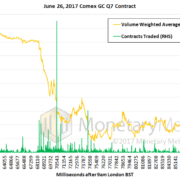Another Look at the Gold Price Drop of 6 November
The prevailing view in the gold community is that banks are speculators who bet on a falling price. To begin, they commit the casino faux-pas of betting on Do Not Pass at the craps table. When everyone wants the price to go up, the banks seem to want it to go down. Uncool.
In contrast to this view, ours is that the banks are arbitrageurs. They aren’t betting on price, they are profiting from the small spreads in between bid and ask, spot and future, future and Exchange Traded Funds.
We thought we would revisit the crash of Nov 6. Recall that our last look was at spot and futures. The quote on spot did not respond to the drop for 79 long seconds. We believe that this was a simply a delay in updating the quote, as spot quotes displayed by the data providers are indicative only. They are not tradeable.
This time, let’s look at the futures market and the leading gold exchange traded fund, GLD.
The Bid and Ask Prices of GLD and the Dec Future

First, notice the time period of the graph. The whole thing occurs in just under a second, at 13:30:01 London time.
Second, note that this occurred an hour before the NYSE opens, so the bid-ask spread on GLD is much wider than normal.
Third, it’s fascinating to see the immediate aftermath of the crash. There’s even a brief period when the bid in the future appears to be above the ask. We are inclined to believe that’s an artifact of the quoting process. But perhaps, in the heat of the moment, the ask price fell below the bid. someone may have had nine nice long milliseconds to take the bank to the cleaners.
Fourth, after that period—around the :555ms mark—we see a relatively flat bid on GLD and ask on the future. So how do we explain the slowly but steadily rising bid on the futures? Our read is that once the selling pressure is over, the market returns to normal with the tight bid-ask spread being achieved by the bid rising near to the ask. We don’t have an opinion on the unstable ask on GLD. Perhaps the market makers were moving it around guessing where things would settle. There may have been some intermittent buying too, thus the upward pressure on the ask while the bid is table flat.
One last thing to note. It does appear as if GLD sold off first. In this data series, the bid and ask prices on GLD drop 24 milliseconds before the future reacts. However, we cannot rule out that this may be an artifact of the quoting process. GLD and futures trade on different exchanges, and it’s possible that the clock on one exchange server could be 25ms ahead of the other.
© 2015 Monetary Metals




Ah… today talk of milliseconds is interesting “Flash Boys” type of material. A good book, too.
Of course, the larger issue is whether gold will climb $100 from here or drop another $100 from here. A few months ago the alleged “fundamental price” of gold — at the time being so much higher than the nominal price — would have had us believe that the coming move was going to be higher. It was not. It was an immediate and relentless drop of $100.00, no small sum in itself, and showing once again — and countless times since 2011 when we began discussing backwardation, etc– that this fundamental price has no predictive value whatsoever. I’m not even sure why it’s called a fundamental price. That makes it sound like it’s somehow better than the price on my computer screen. Maybe it is… but I sure haven’t seen any evidence to support that notion.
In an effort to illuminate the answer to these perplexing issues, several questions from different authors have been posed over the last several weeks/months that remained unanswered. Good questions, too, ones that deserve to be addressed… at least if we are to be honest with ourselves in seeking to understand the limitations of this model.
On the other hand, some will be happy to believe, as if by faith, that we should buy an asset somehow trusting that its fundamental value (again, whatever that is) is higher than the current price. What that suggests is that all the sellers, you see, those who have been selling and selling for the last several months (no, years) are complete idiots while the rest of us… the buyers… are the smart ones.
I admit, to have real money (gold) as opposed to paper truly is a smart move. But that doesn’t mean it will go up in value…. not at all. We live in a very controlled and contrived world… and it may stay that way for awhile… or indefinitely. It would be splendid to think the free market will ultimately prevail. Truth is, it may not. Free markets depend on freedom, and freedom is in a bear market.
bbartlow: I’ve seen many of those headlines too. “This indicator *GUARANTEES* you will make money on gold today! Click here to get started!” And they tell the story of the Assignat, Papiermark, and Zimbabwe dollar. And Backwardation. And that’s why gold has to go to $50,000.
Not here. We don’t do clickbait headlines. We don’t believe you can divide quantity of dollars by quantity of gold to get a gold price, or mix the Narrative of all fiat currencies into discussion of the gold price.
To the irritation of many in the gold community, I often insist that gold does not go anywhere. It’s the dollar that mostly goes down but can go up.
Now, on to what I think is the issue that has got you so upset: price prediction. Philosophically, it’s simple: people buy any asset when they think value > market price. We have developed a model to calculate value based on the constantly evolving dynamic between speculators and hoarders. The good part is that it is data driven, not subject to my or anyone else’s feelings, rumors, partial truths (e.g. import numbers to India), etc.
The bad part is that it does not offer guarantees of the next move. Or is that bad? Well, it’s bad if you bet with leverage on that move. But given the idea that value and price are not guaranteed to align for a potentially long period of time, it’s not bad. It’s just the nature of markets.
I have tried to be clear that the basis is not a recipe for trading the next price move. If the market price can deviate from the fundamental value in the first place, then it can deviate further in the future. The basis analysis has a lot of value, but this is not it.
You may have noticed I have not exactly been jumping up and down about buying gold, though its fundamental is way above its market. One reason is the behavior of the silver market.
One last thing about fundamentals: supply and demand is constantly changing. For example, the fundamental price peaked at $1310 on Sep 10. Since then, it moved mostly sideways, and peaked again at $1303 on Nov 11. Over the next three days, it lost about $100 to near its present value of $1195. So what happened? More gold–physical, metallic gold–came to market. By then, the price move had largely occurred. The price closed at $1086 on Nov 11. For whatever reason, holders of gold sold the metal. Perhaps they feared gold will “go down” even more, or someone on CNBC said that the smart money was selling gold, or they looked at CPI and said there’s no need for an inflation hedge. Who knows? What we do know is that they came to market and they sold. Not paper, not shorting gold. metal.
Sentiment may change tomorrow, and this cannot be predicted. What we can do–what the Monetary Metals fundamental price model does–is assess where price would be if the price impact of leveraged speculators is backed out and supply balances demand.
While the two price scales are not meant to be identical, it should be noted that GLD is not equal to exactly one tenth of an ounce of gold. Currently each GLD is equal to 0.09572778 ounces and that changes each day as the 0.40% management fee is deducted pro rata. The result is that the GLD scale/prices are equivalent to the following spot prices:
106.1 1108.35
106.0 1107.31
105.9 1106.26
105.8 1105.22
105.7 1104.17
105.6 1103.13
105.5 1102.08
105.4 1101.04
105.3 1099.99
105.2 1098.95
105.1 1097.90
It would be interesting Keith if you could rescale the GLD bid/ask accordingly as then that would give us a better idea of what the actual arbitrage profits (to carry or decarry GLD) were during this time (which is probably theoretical anyway as the time period is so small and we are talking about the pre-open period as well). Eyeballing it, it looks like GLD bid and ask were above Futures.